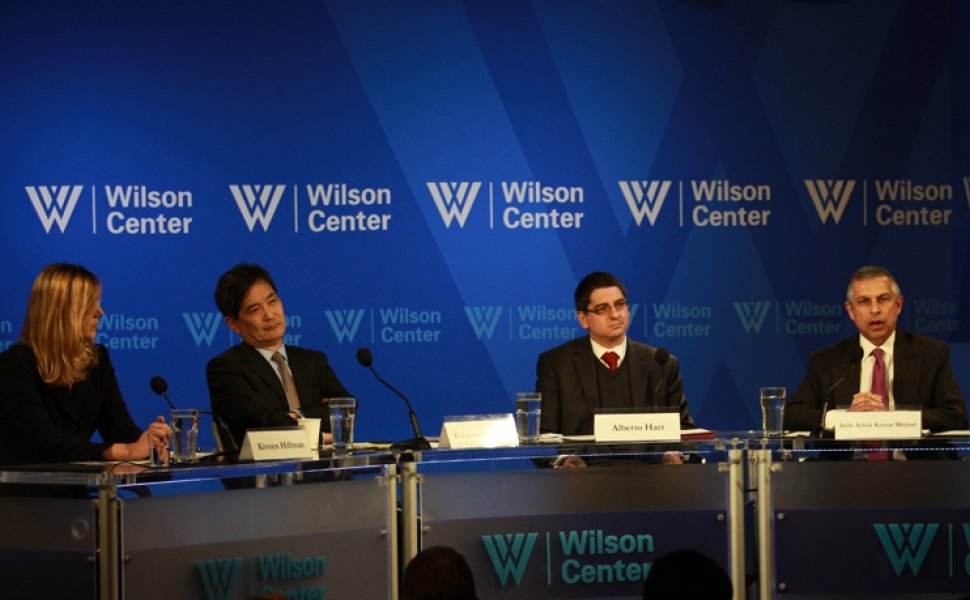The Future of Global Trade under CPTPP


On his first day in office, President Donald Trump formally withdrew the United States from the Trans-Pacific Partnership agreement that had been championed by his predecessor. Just over one year later, the leaders of the eleven countries left behind by this decision gathered in Santiago, Chile to commit to a partnership of their own dubbed the Comprehensive and Progressive Agreement for Trans-Pacific Partnership (CPTPP) or TPP 11.
On March 7th, the Asia Program partnered with the Latin America Program, the Canada Institute, and the Mexico Institute to bring together two panels of experts to discuss the future of globalization under CPTPP. Panelists from Canada, Chile, Japan, Mexico, Singapore, and the United States broke down the challenges and benefits that may lay ahead in their countries.
As Cynthia Arnson, director the Latin America Program, gave her opening remarks she discussed the landscape ahead for free trade and globalization. “The [U.S.] withdrawal from TPP has merely been the opening salvo in an effort to rethink, push back…against multilateral trade agreements, particularly NAFTA and now potentially to erect additional trade barriers.” However, “many Pacific Rim countries see benefits in the deeper integration of their economies.” The Asia Program’s Senior Associate Shihoko Goto agreed, “The eleven countries have clearly demonstrated an appetite for multilateral trade agreements and more broadly for free and open markets.”
Those countries, which are now part of the CPTPP, are Australia, Brunei, Canada, Chile, Japan, Malaysia, Mexico, New Zealand, Peru, Singapore, and Vietnam. Moderated by Shihoko Goto, the first panel of the day’s event focused on four: Singapore, Canada, Japan, and Peru.
The Honorable Ashok Kumar Mirpuri, Singapore’s ambassador to the United States, talked about his years working on the TPP and other trade agreements, pointing out that Singapore has 21 free trade agreements with one of the first being an early 2000s agreement with the United States.
In 2016, “trade became a very difficult topic to discuss in the United States,” Mirpuri said. “The balance of benefits in the TPP had changed,” after the U.S. withdrawal and that required the remaining countries to recalculate if it was worth continuing. They “of course” decided that it was, and he says that for Singapore this was partially based on building opportunities for jobs and businesses in Singapore but also “to maintain the integrity of the TPP” with minimal changes to the established rules.
“It is a smaller agreement without the U.S.,” but still worthwhile, Mirupuri says. “It reflects better the way that business is done today with global supply chains and movement of e-commerce.”
Discussing Japan’s history with the TPP, Deputy Chief of Mission for the Embassy of Japan Katzutoshi Aikawa said, “the timing of the U.S. withdrawal announcement was particularly inopportune for us as the Japanese government had obtained ratification of approval from the Diet just a month prior to the announcement.”
“TPP is expected to provide a potential template for other ongoing regional integration initiatives,” Aikawa said. But also, “today we have a domestic economic imperative to promote TPP.” The Japanese economy has dealt with a deflationary cycle for 20 years and faces problems like a declining population. “So making the most of the expanding markets in the region and generating growth and innovation, TPP will help us better deal with those challenges.”
“TPP is designed to be an open architecture agreement, this is one of the very characteristics that make the TPP special. The door is open for non-TPP countries who are interested in joining,” Aikawa said.
Alberto Hart, the head of the Department of Economics and Environment at the Embassy of Peru, said that there are several countries that have expressed interest in joining the CPTPP through that flexibility.
Kirsten Hillman, former Chief Negotiator for the TPP and Canada’s Deputy Ambassador to the United States also spoke about the openness of CPTPP. “This is an agreement that was specifically designed to grow, it’s specifically designed to attract new countries into its fold and so in that respect the standards that we set in terms of market access and of course the rules that we set are really the gift that will keep on giving as countries come forward and express their interest in joining us in this trade agreement.”
Hillman said that trade agreements both open up markets, but also, “they establish transparent, predictable rules that set an environment for countries or businesses to be able to feel confident that they know the framework under which they are going to be operating within that block of countries” so that they can take advantage of those open markets. The CPTPP helps to establish new rules for the new ways that the global economy works, including e-commerce, and “hopefully help in the economy that we’re moving towards.”
The next step will be ratification by the individual member countries, and for the agreement to take effect, at least six are needed. Aikawa says that “Japan will take the lead in the ratification process as we did in TPP 12.” Though he did point out that the TPP still has detractors in Japan who feel threatened by the changes that it might bring.
Hillman agrees, “there are many citizens in all of our countries who feel…that the promise of international trade and globalization just hasn’t been lived up to in their segment of the economy or their part of our country.” Hillman says those feelings were on the minds of those negotiating the agreements, but that they need to work to communicate with those citizens and to hear what those people have to say.
Goto brought up the possibility of China joining the agreement. Mirpuri responded, “China is an important part of the entire regional economic architecture. If they can come up to the standards of the TPP11, then they should be welcome to join.” But he cautions that they should not create new conditions for any country to join, including the U.S.
Hart said that while Peru’s trade minister has said they would welcome the return of the United States to the agreement under the open architecture of the agreement but “we do have to keep in mind that the objective is to advance trade integration and to benefit our consumers through a greater level of ambition and not the other way around.”
The views expressed are the author's alone, and do not represent the views of the U.S. Government or the Wilson Center. Copyright 2018, Asia Program. All rights reserved.
Guest


Indo-Pacific Program
The Indo-Pacific Program promotes policy debate and intellectual discussions on US interests in the Asia-Pacific as well as political, economic, security, and social issues relating to the world’s most populous and economically dynamic region. Read more


Latin America Program
The Wilson Center’s prestigious Latin America Program provides non-partisan expertise to a broad community of decision makers in the United States and Latin America on critical policy issues facing the Hemisphere. The Program provides insightful and actionable research for policymakers, private sector leaders, journalists, and public intellectuals in the United States and Latin America. To bridge the gap between scholarship and policy action, it fosters new inquiry, sponsors high-level public and private meetings among multiple stakeholders, and explores policy options to improve outcomes for citizens throughout the Americas. Drawing on the Wilson Center’s strength as the nation’s key non-partisan policy forum, the Program serves as a trusted source of analysis and a vital point of contact between the worlds of scholarship and action. Read more


Canada Institute
The mission of the Wilson Center's Canada Institute is to raise the level of knowledge of Canada in the United States, particularly within the Washington, DC policy community. Research projects, initiatives, podcasts, and publications cover contemporary Canada, US-Canadian relations, North American political economy, and Canada's global role as it intersects with US national interests. Read more


Mexico Institute
The Mexico Institute seeks to improve understanding, communication, and cooperation between Mexico and the United States by promoting original research, encouraging public discussion, and proposing policy options for enhancing the bilateral relationship. A binational Advisory Board, chaired by Luis Téllez and Earl Anthony Wayne, oversees the work of the Mexico Institute. Read more
